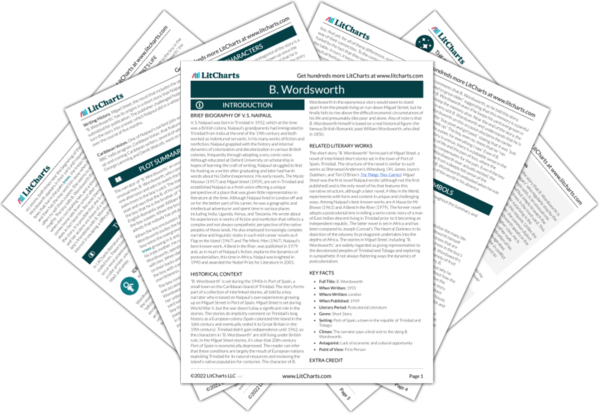In “B. Wordsworth,” the titular character creatively constructs an identity for himself, effectively choosing the kind of person he wants to be. That B. Wordsworth introduces himself to the boy in the beginning of the story as “Black Wordsworth” and says he is the brother of “White Wordsworth,” the 19th-century English Romantic poet, immediately suggests B. Wordsworth’s interest in constructing an identity oriented around the idea of fostering a poetic relationship with the world. His self-professed identity as a brother of the great poet likewise aligns with his claim that he’s writing “the greatest poem in the world,” a project that, like his identity, ultimately turns out to be a fiction (if readers are to believe what he tells the boy at the end of the story). It is a fiction with a purpose, however, as it creatively informs his understanding of himself and his way of seeing the world. The identity that B. Wordsworth has constructed for himself is further reflected in the place where he lives: a one-room hut surrounded by trees and overgrown foliage. Even though B. Wordsworth ultimately disavows the story he told the boy about why he keeps his yard overgrown (to keep alive the memory of a deceased wife and child), the story again seems less a made-up account than an important building block—regardless of its factual accuracy—in B. Wordsworth’s constructed sense of self. The ambiguities surrounding B. Wordsworth’s social identity don’t invalidate who he is, then, but emphasize the lesson he models for the boy: namely, that it’s possible for people to actively construct their own identities, thus freeing them to be whomever or whatever they want to be.
Identity Construction ThemeTracker

Identity Construction Quotes in B. Wordsworth
His English was so good it didn’t sound natural, and I could see my mother was worried.
She said to me, ‘Stay here and watch him while he watch the bees.’
The man said, ‘Thank you, Madam. You have done a good deed today.’
He spoke very slowly and very correctly, as though every word was costing him money.

Unlock explanations and citation info for this and every other B. Wordsworth quote.
Plus so much more...
Get LitCharts A+‘Black. Black Wordsworth. White Wordsworth was my brother. We share one heart. I can watch a small flower like the morning glory and cry.’
He said, ‘Listen, and I will tell you a story. Once upon a time a boy and girl met each other and they fell in love. They loved each other so much they got married. They were both poets. He loved words. She loved grass and flowers and trees. They lived happily in a single room, and then one day the girl poet said to the boy poet, “We are going to have another poet in the family.” But this poet was never born, because the girl died, and the young poet died with her, inside her. And the girl’s husband was very sad, and he said he would never touch a thing in the girl’s garden. And so the garden remained, and grew high and wild.’
He said, ‘But this is a different sort of poem. This is the greatest poem in the world.’
I whistled.
He said, ‘I have been working on it for more than five years now. I will finish it in about twenty-two years from now, that is, if I keep on writing at the present rate.’
You does write a lot, then?’
He said, ‘Not any more. I just write one line a month. But I make sure it is a good line.’
I asked, ‘What was last month’s good line?’ He looked up at the sky and said, ‘The past is deep.’
Our walks continued. We walked along the sea-wall at Docksite one day, and I said, ‘Mr. Wordsworth, if I drop this pin in the water, you think it will float?’
He said, ‘This is a strange world. Drop your pin, and let us see what will happen.’
The pin sank.
He wasn’t looking at me. He was looking through the window at the coconut tree, and he was speaking as though I wasn’t there. He said, ‘When I was twenty I felt the power within myself.’ Then, almost in front of my eyes, I could see his face growing older and more tired. He said, ‘But that—that was a long time ago.’
He said, ‘Good. Well, listen. That story I told you about the boy poet and the girl poet, do you remember that? That wasn’t true. It was something I just made up. All this talk about poetry and the greatest poem in the world, that wasn’t true, either. Isn’t that the funniest thing you have heard?’











